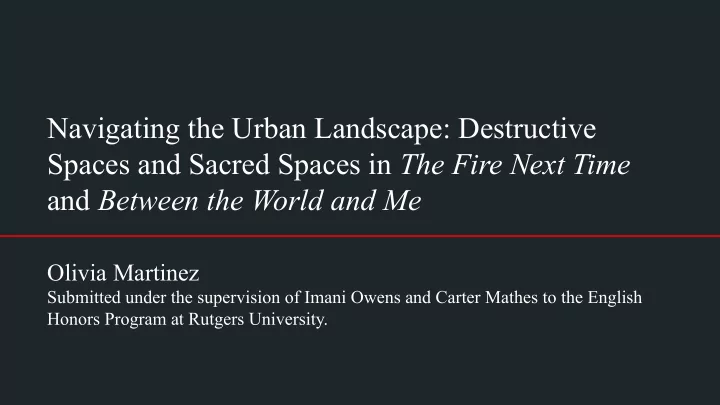

Navigating the Urban Landscape: Destructive Spaces and Sacred Spaces in The Fire Next Time and Between the World and Me Olivia Martinez Submitted under the supervision of Imani Owens and Carter Mathes to the English Honors Program at Rutgers University.
Introduction Primary Texts: The Fire Next Time by James Baldwin and Between The World and Me by Ta-Nehisi Coates Topic: The urban landscapes in The Fire Next Time and Between the World and Me and the authors’ methods of navigation Question: What can be understood about the American city through these texts? Answer: The American city contains both destructive and sacred spaces. Both of these spaces must be navigated in order for survival. Objectives: To show why it is important that these authors offer methods of navigating and surviving the urban landscape
Major Topics for Understanding Spaces 1. American cities 2. Destructive spaces 3. Sacred spaces 4. Navigation
The Fire Next Time and Between the World and Me effectively remap urban spaces to show spots of desperation and disgust, showing the hopelessness condition of cities, which I will call destructive spaces, and uplifting spaces that enabled them to escape the foreseeable destruction their cities were expected to bring to them, which I will call sacred spaces. Both authors create images of their urban landscapes that show how detrimental cities can be to black populations, but that also show spots of hope in which one can rise above the fate that their city has in store for them.
American Cities ● Exploring American cities through Baldwin’s Harlem, New York and Coates’ West Baltimore, Maryland ● Racism as a constant force in the shaping of the American city ● Interchangeable quality of Northern cities with large black populations ○ Shared experiences ● Contain both destructive and sacred spaces ● Navigation is critical for survival
Destructive Spaces ● Inspired by E. Franklin Frazier’s “cities of destruction” ● Baldwin’s Harlem, New York and Coates’ West Baltimore, Maryland ● Limitations to mobility ○ Deterioration of infrastructure and living spaces ○ Fear ○ Lack of opportunity ○ Negative relationship between police and residents ○ Lack of freedom ● Reach beyond cities
Sacred Spaces ● Inspired by Farah Griffin’s “safe space” ● Baldwin’s church and Coates’ Mecca ○ Church: Neighborhood church ○ Mecca: Howard University ● An escape from destructive spaces ● Spiritual ○ Religion ○ Ancestors ● Security and salvation ○ Learning
Navigation ● Epistolary style of writing ○ Intimacy in letters ○ Addressed to kin ● Shared wisdom from experience ○ Gained from condition of American cities ○ Knowledge as power ○ Residents become the city ● Mobility ● Navigation is necessary for survival
“You write in order to change the world, knowing perfectly well that you probably can't, but also knowing that literature is indispensable to the world. In some way, your aspirations and concern for a single man in fact do begin to change the world. The world changes according to the way people see it, and if you alter, even by a millimeter, the way a person looks or people look at reality, then you can change it.” -- James Baldwin, 1979
Bibliography Baldwin, James. 1993. The Fire Next Time. 1st ed. New York: Vintage International. Coates, Ta-Nehisi. 2015. Between the World and Me. New York: Spiegel & Grau. Frazier, E. F. (1939). The Negro family in the United States. Chicago: University of Chicago Press Griffin, Farah Jasmine and F. J. Griffin. 1995. Who Set You Flowin? The African-American Migration Narrative Oxford University Press. doi:10.1093/acprof:oso/9780195088960.001.0001. Romano, John. “James Baldwin Writing and Talking.” The New York Times. The New York Times, September 23, 1979. https://www.nytimes.com/1979/09/23/archives/james-baldwin-writing-and-talking-baldwin-baldwin-a uthors-query.html.
Recommend
More recommend